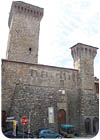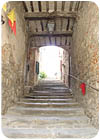
Local travertine and Pietra Serena were combined with brick
for much of the medieval architecture in Lucignano, Italy. This is true of the
city’s main arches, including Porta S. Giusto.

The Rocca, or Cassero Senese, stands among
the town walls as the centerpoint of the city’s
defense. Conceived by architect Bartolo Bartoli and
made of local stone, the Rocca has a square shape
and projects an image of strength above the main
public square.

The
Rocca can be seen at multiple points throughout Lucignano.

The Collegiata di San Michele Arcangelo also utilizes native
travertine, along with brick and Pietra Serena. It was rebuilt in 1593,
although only the lower portion of the facade was finished.
The portal was made by Pietro Antonio Morozzi in 1715, and the flight of steps
was
made by Andrea Morozzi, who is also thought to have made the
bell tower. The church has a Latin cross plan with a nave and a hemispheric
dome.

With a population of nearly 3,500 that caters
primarily to the tourist trade, Lucignano proudly
celebrates its medieval roots, with medieval banners
adorning walls and buildings throughout the
town.